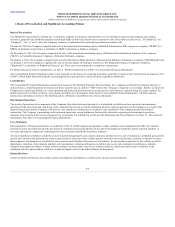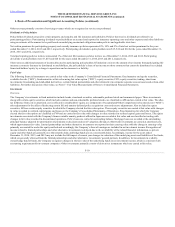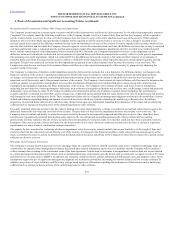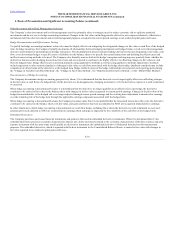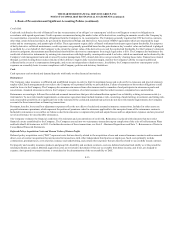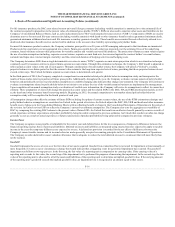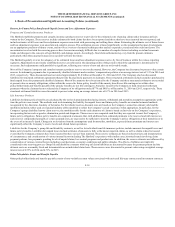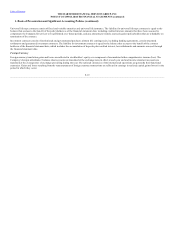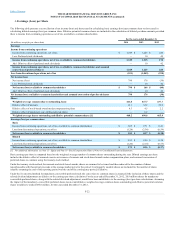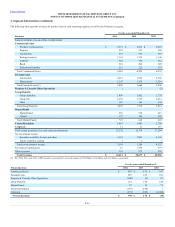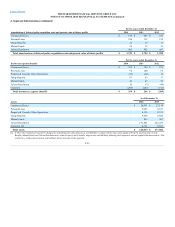The Hartford 2014 Annual Report Download - page 152
Download and view the complete annual report
Please find page 152 of the 2014 The Hartford annual report below. You can navigate through the pages in the report by either clicking on the pages listed below, or by using the keyword search tool below to find specific information within the annual report.
Table of Contents
Management’s determination of the fair value of each reporting unit incorporates multiple inputs into discounted cash flow calculations, including
assumptions that market participants would make in valuing the reporting unit. Assumptions include levels of economic capital, future business growth,
earnings projections and assets under management for certain reporting units and the weighted average cost of capital used for purposes of discounting.
Decreases in the amount of capital allocated to a reporting unit, decreases in business growth, decreases in earnings projections and increases in the weighted
average cost of capital will all cause a reporting unit’s fair value to decrease.
Goodwill within Corporate is primarily attributed to the Company’s “buy-back” of Hartford Life, Inc. in 2000 and was allocated to each of Hartford Life’s
reporting units based on the reporting unit’s fair value of in-force business at the buy-back date. Although this goodwill was allocated to each reporting unit,
it is held in Corporate for segment reporting.
Property and Equipment
Property and equipment is carried at cost net of accumulated depreciation. Depreciation is based on the estimated useful lives of the various classes of
property and equipment and is determined principally on the straight-line method. Accumulated depreciation was $2.3 billion and $2.2 billion as of
December 31, 2014 and 2013, respectively. Depreciation expense was $198, $174, and $183 for the years ended December 31, 2014, 2013 and 2012,
respectively.
Separate Accounts, Death Benefits and Other Insurance Benefit Features
The Company records the variable account value portion of variable annuity and variable life insurance products and institutional and governmental
investment contracts within separate accounts. Separate account assets are reported at fair value and separate account liabilities are reported at amounts
consistent with separate account assets. Investment income and gains and losses from those separate account assets accrue directly to the policyholder, who
assumes the related investment risk, and are offset by the related liability changes reported in the same line item in the Consolidated Statements of
Operations. The Company earns fees for investment management, certain administrative expenses, and mortality and expense risks assumed which are
reported in fee income.
Certain contracts classified as universal life-type include death and other insurance benefit features including guaranteed minimum death benefit ("GMDB"),
guaranteed minimum income benefit ("GMIB"), and guaranteed minimum withdrawal benefit ("GMWB") riders offered with variable annuity contracts, or
secondary guarantee benefits offered with universal life insurance contracts. GMWBs that represent embedded derivatives are accounted for at fair value.
Universal life insurance secondary guarantee benefits ensure that the policy will not terminate, and will continue to provide a death benefit, even if there is
insufficient policy value to cover the monthly deductions and charges. For the Company's GMWB products, the withdrawal benefit can exceed the
guaranteed remaining balance ("GRB"). These GMDBs, GMIBs, the life-contingent portion of GMWBs and the universal life insurance secondary guarantees
require an additional liability be held above the account value liability representing the policyholders’ funds. This liability is reported in reserve for future
policy benefits in the Company’s Consolidated Balance Sheets. Changes in the death and other insurance benefit reserves are recorded in benefits, losses and
loss adjustment expenses in the Company’s Consolidated Statements of Operations.
The death and other insurance benefit liability is determined by estimating the expected present value of the benefits in excess of the policyholder’s
expected account value in proportion to the present value of total expected fees. The liability is accrued as actual fees are earned. The expected present value
of benefits and fees are generally derived from a set of stochastic scenarios, that have been calibrated to our RTM separate account returns, and assumptions
including market rates of return, volatility, discount rates, lapse rates and mortality experience. Consistent with the Company’s policy on the Unlock, the
Company regularly evaluates estimates used and adjusts the additional liability balance, with a related charge or credit to benefits, losses and loss adjustment
expense. For further information on the Unlock, see the Deferred Policy Acquisition Costs and Present Value of Future Profits accounting policy section
within this footnote.
The Company reinsures a portion of its in-force GMDB and all of its universal life insurance secondary guarantees and net reinsurance costs are recognized
ratably over the accumulation period based on total expected assessments.
F-17



